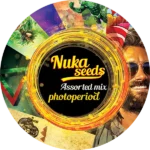English
Azadirachta indica (Neem oil)
It is the most commonly used insecticide in cannabis cultivation. Azadirachta indica, containing nimbin, grows in tropical climates. Its seeds are first dried and then made into neem oil.
This oil is obtained by cold pressing the seeds without the use of solvents. The product is then filtered. The oily liquid thus obtained solidifies at a temperature below 20 °C. The solid oil can be liquefied by holding the bottle under a stream of hot water. The oil has an almost opaque brown colour and a characteristic strong spicy smell.
In its pure form, the oil can be used as a disinfectant against various strains of bacteria and its vapours have disinfectant effects against many types of mould. The oil is very effective in the fight against tetranychus, sciaridae larvae and aphids.
Spray the cannabis with oil dissolved in water, especially the underside of the leaves. You can also spray the substrate with this solution. This is a systemic pesticide (acting through the vascular system) which is effective for approximately one month. The active ingredients are azadirachtin, nimbin and salanine.
Some scientific studies have shown that azadirachtin is a very effective element, attacking Ekdyson, the growth hormone of insects. Normal insect growth is suppressed and further spread does not continue.
Azadirachtin also causes deformations in the nervous system of insects. In addition, nimbin and salanine are very effective substances that slow down the insect’s digestive system. The action of these substances reduces the insect’s ability to digest. They also have a repellent effect.
Neem oil is non-toxic and have no effects on warm-blooded animals (vertebrates) or humans. It is therefore an interesting alternative compared to other pyrethrin-based insecticides which are (slightly) toxic to warm-blooded animals.
Pyrethrin
Pyrethrin is a chrysanthemum extract that is very effective in fighting a wide range of insects. It works very well against flying insects. It causes nervous system poisoning and paralysis of insects. Due to its short period of effectiveness, it can only be used for therapeutic purposes. Unfortunately, it is toxic to all insects and, like rotenon, pyrethrin is fatally poisonous to fish and amphibians.
Rotenone

Rotenone powder is a colorless, odorless, crystalline isoflavone used as a broad-spectrum insecticide, piscicide, and pesticide. It occurs naturally in the roots of plants such as grapevines. Rotenone is classified by the World Health Organization as moderately hazardous. It is slightly toxic to humans and other mammals, but very toxic to aquatic insects and fish.
Diatomaceous earth
You can also use diatomaceous earth as a natural and non-toxic insecticide. In the home, it can be used to control unwanted pests such as ants, cockroaches, ladybugs, fleas, beetles, slugs and mites. How is this possible?
Diatomaceous earth dust has razor-sharp edges, and these are deadly to insects. It breaks down the outer skeletal layer and the insect dies quickly. Just sprinkle diatomaceous earth powder on the areas where pests are most prevalent.
Glycerol-glycerine
The same kind used in soaps can be used against insects with soft body parts such as tetranychus, thrips and moths. When insects come into contact with glycerin, they suffocate.
Bordeaux mixture
This preparation based on copper sulphate and lime has been used for centuries as a prevention against many types of mould. More and more modern anti-mould products combine blue rock with other chemical elements, but only Bordeaux clay is used in organic farming.
Sulfur

Sulphur is effective against mould and has been used for this purpose for centuries. Sulphur must not be used at temperatures above 35 °C and relative humidity below 50%, otherwise it will ignite !
Sulphur kills moulds by contact with them. The main theory of how sulfur works is that it enters the mold cells and affects cellular respiration. Sulfur can kill insects if they touch it or eat it. It interferes with their normal bodily functions and alters their ability to produce energy.
Published by Peca Sarm
30/03/2022choose and buy cannabis seeds from our offer
our pleasure





























